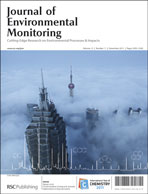A range of organochlorinated compounds have been consumed in China, India and the countries of mainland southeast Asia (MSA). Considering their persistence in the environment and ability in long-range atmospheric transport (LRAT), the potential outflow of these compounds from this region is therefore of great concern in the context of the global distribution of toxic chemicals. As part of a monitoring campaign aimed at investigating the LRAT of organochlorine pesticides (OCPs) and polychlorinated biphenyls (PCBs) from southern China, MSA and northern India, atmospheric levels of OCPs and PCBs were measured once a week from October 2005 through December 2006 at Tengchong Mountain (TM), a remote site located in south-western China. The average concentrations of OCPs were found to be higher than those in other remote stations in the Arctic and the Tibetan plateau, except for α-hexachlorocyclohexane (α-HCH). A high level of β-HCH and low α-HCH/β-HCH ratio was attributed to an accidental release of β-HCH from unknown sources, besides obvious evidence of lindane (γ-HCH) and technical HCH usage. Temporal variations of chlordanes and endosulfan were related to the usage pattern of these compounds, as well as LRAT. In contrast, dichlorodiphenyltrichloroethane (DDT) exhibited a relatively minor seasonal variation. The OCP levels at the monitoring site were found to be related to the air parcel back trajectories on the basis of four distinct clusters. Elevated levels of HCHs and DDTs were observed when air parcels originated from northern India where considerable OCP usage was reported recently, while high levels of γ-HCH and TC (trans-chlordane) were mainly associated with air masses from southern China and northern MSA. The study highlighted the high background level of OCPs as well as their temporal patterns of trans-boundary LRAT in the MSA region.

You have access to this article
 Please wait while we load your content...
Something went wrong. Try again?
Please wait while we load your content...
Something went wrong. Try again?


 Please wait while we load your content...
Please wait while we load your content...